Hugh Murton Le Fleming Challenger & Big Boy |
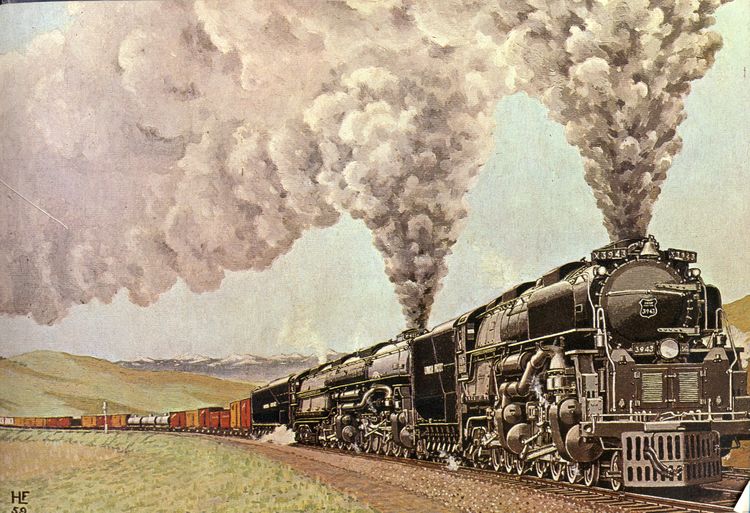 |

Hugh Murton Le Fleming Challenger & Big Boy |
 |
The lack of certain pages on the steamindex website is a sad reflection on the narrow vision of most railway enthusiasts, who in the case of those born in Great Britain are more interested in the differences between Nos. 4999 and 4500 than in the exciting locomotives which used to pound their way towards the Rockies. As Le Fleming did not play a prominent role in British locomotive literature he has been ignored until now. Even his contribution to the RCTS magnum opus the Locomotives of the Great Western Railway has been under-played.
The introductory material to the subject's International locomotives forms the core of this page.
About the Artist [written by Rosalind Le Fleming with minor modifications]
Hugh Murton Le Fleming was born in Wimborne, Dorset on 11 June 1902, the elder son of Dr Le Fleming, later Chairman of the British Medical Association. Educated at Tonbridge School and Clare College, Cambridge, he was a pupil under C.B. Collett at the Great Western Railway Works at Swindon from 1923 to 1925. After service as an Inspecting Engineer for the Crown Agents, concerned mainly with locomotive construction, he joined the Federated Malay States Railway in 1929 as Assistant District Locomotive Superintendent, in 1931 became Chief Draughtsman in Kuala Lumpur and between 1938 and 1941 was Works Assistant and Assistant to the CME. His health, however, had deteriorated and in September 1941 he was invalided out of the tropical service. This fact prevented fulfilment of his ambition to join the Navy but he obtained the post of Assistant Supply Officer in the Admiralty, being promoted later to Production Engineer. He resigned in 1946 and, never again very strong, died on 10 November 1961 at his home in Chiswick, leaving a widow and one son.
There was never any real doubt as to what Hugh Le Fleming's profession would be, although for a time in his early twenties he did play with the idea of becoming a professional painter and living in a garret in Paris. However the necessity of earning a more reliable living, especially when the prospect of marriage loomed up, caused this idea to be abandoned in favour of a career in engineering. From earliest youth he had been fascinated by engines and ships as are many boys, but in his case the attraction lasted and deepened. Very early he knew and was drawing the locomotives to be seen locally and first saw the 'inside' of an engine when taken over the old Somerset & Dorset shed at Wimborne. As soon as he was old enough to escape for expeditions on his own, pocket-money and occasional tips were spent on journeys up the line to spots where, for instance, the Somerset & Dorset crossed the main line from London and a day's good 'bag' of engines could be assured. On visits to London when he was still a small boy his mother, no doubt like many another devoted parent, would spend hours with him at Paddington or hastening between Euston and King's Cross to see particular engines.
While at Cambridge, in 1921, he spent his first 'long vac.' at the Southern Railway's Works at Eastleigh. After the war there had been family holidays on the Continent and this was the period, too, when there began his trips abroad with friends to study foreign locomotives and ships, which, in competition with the pursuit of all his other interests—such as Egyptology and the Ancient World, picture galleries, fine scenery, tropical butterflies and nature study in general—remained his favourite pattern for holidays all his life.
When he obtained his first post on the FMS Railway he maintained that he "must have got into the wrong queue", and certainly he and his wife had been diligently learning Spanish, under the impression that he might be getting a job in South America! His former preparatory school, recording this appointment of an old boy, quipped that it was a job he had already seemed qualified for when he left the school. Be that as it may, the work in Malaya was of great interest to him professionally and in addition gave wonderful scope for the pursuit of some of his 'lay' interests. (He even discovered a new jungle bug that was named after him).
When he was in charge of the locomotive running department of the Northern district of Mala ya the job entailed travel right up to the Siamese border and included inspection of the East Coast line, then under construction through virgin jungle. One such journey, his wife remembers, was completed in the dark on the footplate of the engine of the construction line as far as this then reached. The arrival of an inspecting officer from headquarters was bitterly resented by the construction engineer, who arranged that the engine should leave without them on their final day, so that they were marooned and, after a long wait and a slight skirmish with water-buffaloes, only escaped by hailing one of the rare boats on the river.
Between 1931 and 1941, at the Kuala Lumpur (Sentul) workshops, Hugh Le Fleming was responsible for standardisation of locomotive details and reorganisation of the Drawing Office. His most important work in design was the 3-cylinder 4-6-2 engines of 'O' class, the most successful and numerous class on the FMSR and the last steam class to be built. Mr L. Bennett, who served in the Works at this time, remembers also that "Hugh was very keen on riding on footplates to see for himself how the loco behaved and, as far as I know, he was the only 'officer' of our staff who could say he had travelled on the footplate throughout the whole of our system."
During the war his work concerned warships and their armament. The strain of those years m Portsmouth and Bath, with constant journeys to armament works in the North further impaired his health and precluded his undertakmg another regular job after his resignation from the Admiralty. The remamder of his life he devoted to painting and the writing of books and a very large number of articles. For financial reasons he took on for a time a series of commissions for the Locomotive Publishing Company, becoming 'F. Moore' of those days. These F. Moore pictures were large photographs overpainted in oils and bearing the signature of the original, long-dead Mr Moore. Hugh Le Fleming's writings during this final period included a history of the locomotives of the FMSR, a series of articles on his favourite American locomotives, several sections of the Concise Encyclopaedia of World Railway Locomotives and a large number of books on ships, such as Warships of World War I, concise histories of the ships of the Blue Funnel and Holland America Lines and 44 editions of the Ian Allan ABC series. With J.H. Price he collaborated in what has been described as an outstanding book on Russian steam locomotives. Having for so many years collected data, planned and indeed started writing a history of Great Western engines he naturally became a leading spirit and one of the principal compilers of the [RCTS] Locomotive History of the GWR in which work his technical, Swindon training and researches were of great importance.
All this did entail a great deal of research, pursued with the passion
for accuracy that came to be recognized as one of the outstanding qualities
of all his work, whether in writing or painting, and by which he avoided
perpetuating mistakes of earlier writers and sometimes brought hitherto unknown
details to light.
This, together with his fund of historical knowledge and the technical background
many others lacked, led to his constantly being asked for information and
help. It was characteristic of the man to supply this with unfailing generosity,
regardless of the time such correspondence might take.
And time, as it turned out, was of the essence, for he died at the early age of 59 leaving more unfulfilled work than could have been completed even in a long life-time.
Mention has been made of his early 'engine-hunting' travels. These continued all his life, with careful planning—not only to see particular engines but if possible to see them working on especially interesting sections —, with footplate passes and permits to visit sheds and works. His 12-year service in Malaya with periodical 'long leaves' provided opportunities for returning home via Japan, Canada and South Africa, besides many more trips to European countries especially Germany. Local annual leave allowed visits to Siam, Java and Sumatra. In 1933 he went as a delegate to the International Railway Congress in Cairo. Characteristically he worked out, for use with his free pass, the longest possible route through Europe. In 1937 came one of the greatest highlights of his whole life, when he went on a tour of his favourite United States railways, with footplate passes on the gigantically powerful freight steam locomotives that were so soon to disappear. As one obituary stated: "He must have been one of the very few Englishmen to have hand-fired an American Mallet locomotive over the Rockies". But little of his graphic and often amusing description of riding on these enormous engines appeared in his articles. Told with his characteristic humour and often sharp wit those more personal impressions enlivened the 'Talks' he gave to various societies or were reserved for a book of reminiscences that was never to get written.
All these travels—including still more to the Continent and one to Russia since the war— not only provided material for books and articles but resulted in notebooks full of sketches and records of engine liveries and scenery, the data for future oil-paintings. He had, of course, continued to paint during the Malayan years— engines, ships, landscapes, even some portraits —besides posters etc. for the railway and other local bodies. Many of these pictures, including over 30 of engines, were subsequently destroyed during the Japanese occupation, together with the coloured sketches for many more. Others, in the possession of friends now dead, are probably no longer in existence, as, no doubt, is the case of the painting The Bangkok Mail, once owned by the great German firm of Hanomag.
Among what survived in England, however, besides notes for projected articles on locomotives, were files galore of completed chapters or condensed notes bearing witness to what he hoped to achieve. There was, for instance, begun many years before but added to from time to time, the plan, some developed parts and drawings for what could have been his chief work, entitled simply The Locomotive. Latterly, conscious that he might not have a long life, he had concentrated more on a work that was to be entitled Locomotive Design as a Fine Art, or possibly, The Fascination of the Railway Engine, in which the aim would be to "bridge the gulf between the 'story-book' and the technical manual".
In this he set out to explain his idea of the aesthetic appeal of the locomotive, "in which the cylinder is combined with the square and the circle in different aspects ... a fascinating matrix of cylinders bonded together with rectilinear framework." In additional clarification of his viewpoint there was one chapter entitled 'The ugly locomotive.' For the painting of what he called his "Locomotive Portraits" he divided the picture into three parts. First, the locomotive, "itself being a work of art", should be painted in full detail and with perfect accuracy, with such modifications made to the original design at any time that had improved its looks. Secondly, what he called "connected features" —rolling-stock, track, signals etc.—were to be painted in less detail and, thirdly, the background, in still less, so as not to distract attention. The background, however, should be "arranged" to suit the design, rhythm and composition of the picture and, while being typical of the scenery or locale in which the engine could normally be seen, was not necessarily to be the picture of one actual spot. The colour-pattern of the painting "starts of course from the fixed, actual colouring of the engine". Colour and shading could be slightly enhanced and reflections minimized, to bring out points of design.
To meet criticisms that his engines looked too much as though newly "hatched" from the shops and less picturesque or lifelike than had they shown more dirt and signs of service, he wrote: "The engine itself is to be clean and not begrimed", and as it were, "a portrait in best clothes rather than in an old gardening suit". Criticism of too minute detail he countered with the note: "cf [compare] Holbein, Van Eyck, every bead, every thread." In short, his locomotive portraits were evidently to be painted in the tradition of the Old Masters rather than in that of the Impressionists or Picasso.
Obituary notices spoke of Hugh Le Fleming as "invariabl sociable and cheerful," "the most approachable of men", "a valued and knowledgeable friend", while Dr·P. Ransome Wallis, with whom he went on several trips, described him as "always the most courteous, interesting and stimulating companion". He was also the most modest of men and would, one knows, have been astonished at the tributes paid to him after his death. Above all, would he have been pleased and happy that The Institution of Mechanical Engineers should have considered reproducing the portraits of his beloved steam engines. R Le F
Narrator's Notes In preparing the captions, or narratives for these paintmgs of the late. Hugh Le Fleming, I have avoided the temptation to enter into lengthy technical descriptions. Firstly, of course such details are readily available in both book and journal form, and there seems no point in simply repeating information accessible elsewhere. Secondly, the paintings are all 'alive', and redolent with the character of the locomotives themselves and of the railways upon which they operated: something no list of dimensions and accessories can convey. Thus, each has been described in the easy manner which the artist used himself, when showing his paintings—pointing out technical and historical features of interest, but not elaborating upon them. Many matters set down in the narratives in the present work were thus recounted to the writer by Hugh Le Fleming directly. A.E.D.
The Institution of Locomotive Engineers obituary adds little, but includes the strange statement that: "Less widely known is the very fine collection of his own oil paintings portraying, with the same technical accuracy which informed his writing, a great number of locomotives and ships from all over the world" His bibliography on marine topics is extensive,.
International locomotives from the collection
of paintings by the late H.M. Le Fleming.with descriptive materail
by A.E. Durrant; edited J.B. Snell. London: Institution of Mechanical Engineers.
1972. 192pp.
Copy seen from Hertfordshire County Library
Russian steam locomotives with J.H. Price. London: John Marshbank, 1960. 110pp. + plates
 |
Other paintings from International locomotives. A further six reproductions of reproductions are appended. KPJ is uncertain whether he really likes Le Fleming's paintings. He has no reservations about the huge American beasts, or their German or Austrian counterparts. He less happy about the British subjects possibly because the rolling stock is only lightly depicted: a picture of a Caledonian Railway 4-6-0 was not included as the rolling stock looks far too like that of a 1930s Great Western train. Similar objections apply to a North Eastern V1 4-4-2 where the green of the locomotive is too much like lime and the crimson of the rolling stock is too plum. He realises that this may be a case of faults in reprography which has greatly improved since 1972. Further, it is unlikely that he saw any of the pre-1914 subjects with the eye which was still to be trained at Swindon. It is scarcely surprising that what appears to be his best British work is of Great Western locomotives.
 |
Plate 22 Great Western Railway 3600 and 2600 classes pp. 50-1 |
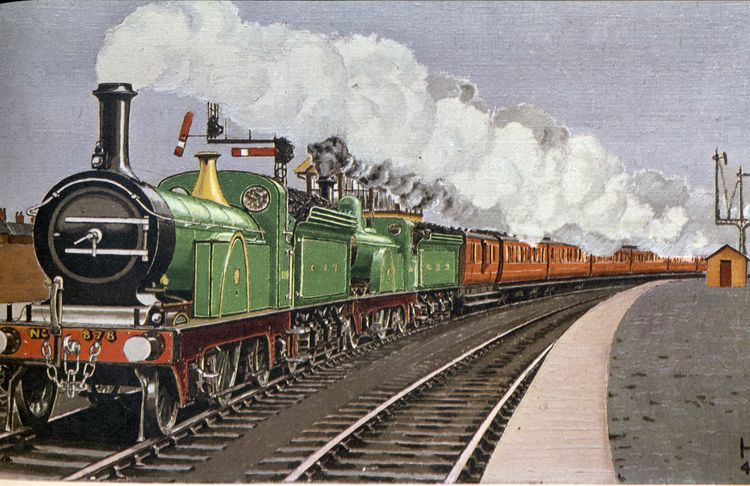 |
Plate 28 Great Northern Railway Stirling 2-2-2s pp. 62-3 |
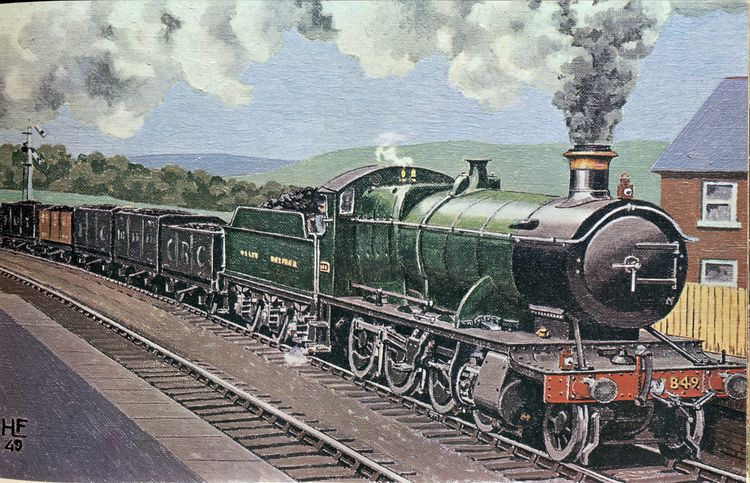 |
Plate 31 Great Western Railway 2800 class 2-8-0 pp. 68-9 |
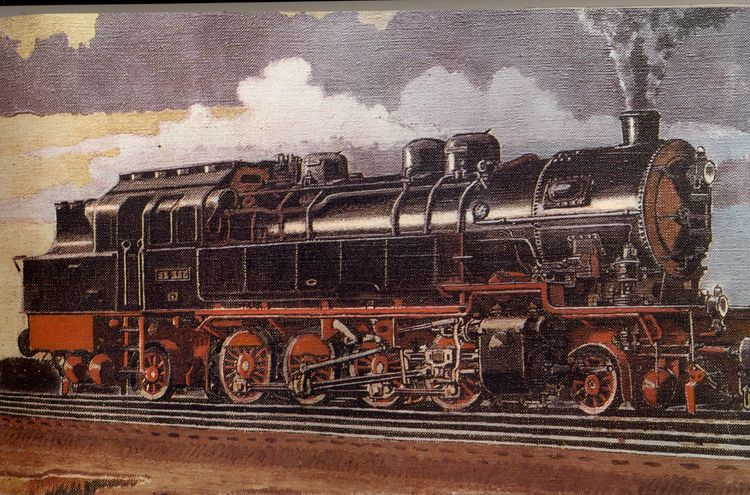 |
Plate 58 Prussian State Railways Class T141 2-8-2T pp. 122-3 |
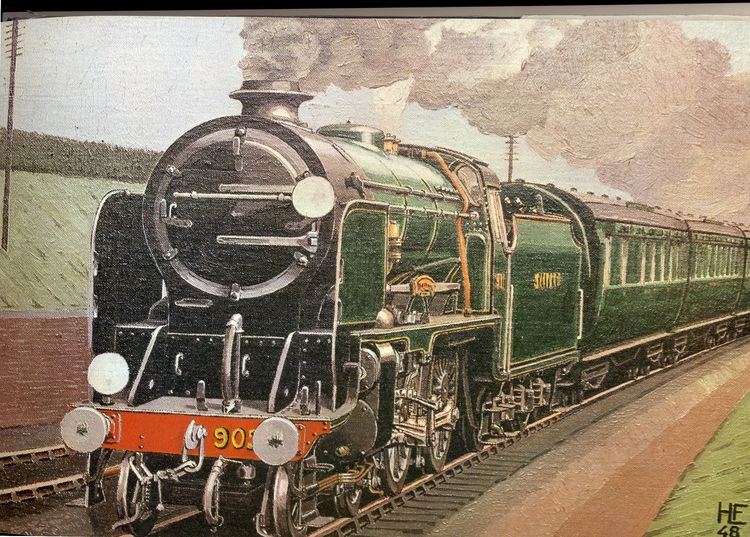 |
Plate 78 Southern Railway 'Schools' class 4-4-0 pp.162-3 |
 |
Plate 60 Virginia Railway 2-10-10-2 pp. 126-7 |
Full list of plates
Plate 1 Great Western Railway 'Sir Alexander'
2-2-2 page 8 [No. 999]
Plate 2 Somerset and Dorset Joint Railway 2-4-0 No 15A page
10
Plate 3 'American Standard'. 4-4-0 page 12
Plate 4 Paris-Orleans Railway page 14
Plate 5 Austrian Southern Railway 0-6-0 page 16
Plate 6 Great Western Railway 2-4-0 No. 1383 and 0-6-0T No.
1833 page 18 [tank engine wih side tanks]
Plate 7 Great Western Railway'Metropolitan' 2-4-0T page 20
[No. 975 with condensing gear]
Plate 8 Caledonian Railway 7ft 2in 2-4-0 page 22 [Connor
design]
Plate 9 Great Western Railway 0-6-0 No. 57 page 24
Plate 10 London and North Western Railway Webb compound 2-2-2-0
page 26
Plate 11 Great Western Railway 2361 class 0-6-0 page 28
Plate 12 North British Railway 4-4-0T page 30 [No.
111]
Plate 13 Glasgow and South Western Railway 0-4-4T page 32
[No. 270]
Plate 14 South Eastern and Chatham Railway 4-4-0 Class F page
34 [No 222]
Plate 15 Highland Railway Jones 4-4-0 page 36 [No.
37]
Plate 16 Midland and Great Nortern Railway Johnson 4-4-0 page
38 [No. 77 in yellow livery]
Plate 17 Great Western Railway 3001 class 4-2-2 page 40
[No. 3060 leading with domed boiler and one with domeless boiler next
train]
Plate 18 Great Eastern Railway 2-4-0 and 4-2-2 page
42 [No. 769 leading: both blue]
Plate 19 Great Western Railway 3571 class 0-4-2T page 44 [No
3579]
Plate 20 Great Western Railway Group 0-6-0Ts at Worcester
page 46 [Swindon and Wolverhampton pannier and saddle tank
engines]
Plate 21 Ceinture Railway, Paris tandem compound 4-6-0T page
48
Plate 22 Great Western Railway 3600 and 2600 classes page
50
Plate 23 Great Western Railway 4-4-0 No 4172 page 52
[Gooch]
Plate 24 Hungarian State Railways Class 222 4-4-0 page 54
Plate 25 Belgian State Railways locomotive group page 56 [2-4-2 tender
locomotives with triple-barrel boilers, square chimneys, etc]
Plate 26 Royal & Imperial Austrian State Railways Class 60 2-6-0 page
58
Plate 27 Netherlands State Railway Class 1700 4-4-0 page
60
Plate 28 Great Northern Railway Stirling 2-2-2s page
62
Plate 29 Midland Railway 4-2-2 express singles page
64 [Nos. 689 and 674]
Plate 30 North Eastern Railway 4-4-0 and 4-2-2 doubleheader
page 66 [No 1877 leaading]
Plate 31 Great Western Railway 2800 class 2-8-0 page
68
Plate 32 Great Western Railway 2900 class 4-6-0 page 70
[No. 2935 Caynham Court]
Plate 33 Belgian State Railways Class 8 4-6-0 page
72
Plate 34 Great Northern Railway compound 4-4-2 No 292 page
74
Plate 35 Prussian State Railways 'Unifiow' locomotives page 76 [S6 4-4-0
and S102 4-6-0]
Plate 36 Eastern Railway of France Series S 4-4-0 page 78
Plate 37 Northern Railway of France 4-6-0 3.539 page
80
Plate 38 London Brighton and South Coast Railway Class B4X
4-4-0 page 82 [No 206 in umber livery]
Plate 39 London and North Western Railway 'George V' class
4-4-0 page 84 [No 1360 Fire Queen]
Plate 40 Caledonian Railway 903 class 4-6-0 page 86
[Cardean]
Plate 41 Swedish State Railways inside-cylinder Atlantic No. 1024 page
88
Plate 42 North Eastern Railway Class V1 4-4-2 page 90 [No
697: very light green]
Plate 43 Great Western Railway 'Star' and 'King' 4-6-0s
page 92 [No. 6027 King Richard I and No. 4038 Queen
Berengaria?]
Plate 44 Prussian State Railways Class S101 4-6-0 page
94
Plate 45 London and South Western Railay Class T14 4-6-0 page
96 [No 444]
Plate 46 Royal & Imperial Austrian State Railways Class 110 2-6-2 page
98
Plate 47 Northern Railway of France 4-6-4 No. 3.1102 page
100
Plate 48 Great Northern Railway Class O1 2-8-0 page 102 [in
apple green livery]
Plate 49. Italian State Railways Class 745 2-8-0 page 104
Plate 50 Central Railroad of New Jersey 'Camelback' 4-8-0 page 106 [No
477]
Plate 51 Bavarian State Railways Class G4/5H 2-8-0 page
108
Plate 52 Great Central Railay 'Director' class 4-4-0 page
110 [No. 436 Sir Berkeley Sheffield]
Plate 53 Portuguese Railways 1501 Class 4-6-2 page 112
Plate 54 Swedish State Railways Class 4-6-2 page 114
Plate 55 Baden State Railways Class IVh 4-6-2 page 116
Plate 56 Bavarian State Railways, shed scene page 118
Plate 57 Saxon State Railways Class Xth 4-6-2 page 120
Plate 58 Prussian State Railways Class T141 2-8-2T page
122
Plate 59 New York Central Railroad Class CCIS 0-8-8-0 page
124 [No 7102]
Plate 60 Virginian Railway 2-10-10-2 page 126
Plate 61 Pennsylvania Railroad Class A5s 0-4-0 page
128
Plate 62 Great Eastern Railway Class D81 0-6-0 page 130 [No.
1271 in grey livery]
Plate 63 Lancashire and Yorkshire Railway Hughes 0-8-0 page
132
Plate 64 Norwegian State Railways Class 31D 4-8-0 page 134
Plate 65 Austrian Federal Railways Class 113 4-8-0 page 136
Plate 66 Danish State Railways Class H 2-8-0 page 138
Plate 67 Lübeck-Büchener Eisenbahn 2-8-0 page
140
Plate 68 London and North Eastern Railway Class A1 4-6-2 page
142 [No 2575]
Plate 69 German group heavy three-cylinder power page 144
Plate 70 German State Railways Class 80 0-6-0T page 146
Plate 71 Eastern Railway of France Series 13 4-8-2 page 148
Plate 72 Great Northern Railway (USA) class R1 4-8-4 page 150
Plate 73 Union Pacific Railroad 9000 class 4-12-2 page 152 [No 9080]
Plate 74 Northern Pacific Railway 9000 Class 2-8-8-4 page 154
Plate 75 Denver and Rio Grande Western Railroad Class Z8 4-8-2 page
156
Plate 76 London Midland and Scottish Railway high pressure
compound 4-6-0 No 6399 page 158 [painted grey]
Plate 77 German State Railways 4-6-2 Class HO210 page
160
Plate 78 Southern Railway Schools class 4-4-0
page 162
Plate 79 Czechoslovakian State Railways Class 387.0 4-6-2 page 164
Plate 80 Chicago, Milwaukee St Paul and Pacific Railroad Class F6 4-6-4 page
166
Plate 81 Reading Railway 2-10-2 No 3014 page 168
Plate 82 Indiana Harbour Belt Railroad three cylinder 0-8-0 page 170
Plate 83 Duluth. Missabe & Northern Ralroad 0-10-0 page 172 [No
92]
Plate 84 Halberstadt-Blankenburgher Railway 2-10-2T page 174
Plate 85 Norwegian State Railways 49a Class 2-8-4 No. 463 'Dovregubben' page
176
Plate 86 London, Midland and Scottish Railway Class 8P 4-6-2
page 178 [No. 6230 post-WW2 black livery without smoke defectors]
Plate 87 Northern Pacific Railway Class Z9 4-6-6-4 page 180
Plate 88 C hesapeake and Ohio Railway Class H7 2-8-8-2 page 182 [No
1577]
Plate 89 Union Pacific Railroad 'Challenger' 4-6-6-4 and 'Big Boy' 4-8-8-4
page 184
Plate 90 Norfolk and Western Railway Class Y5 2-8-8-2 page 186
Plate 91 Russian Railways Class P36 4-8-4 page 188
Plate 92 Pennsylvania Railroad Class T1 4-4-4-4 page 190